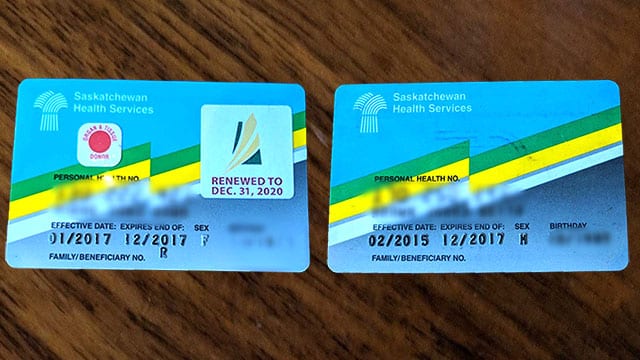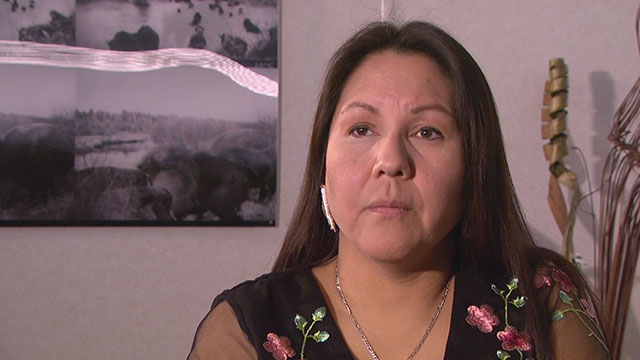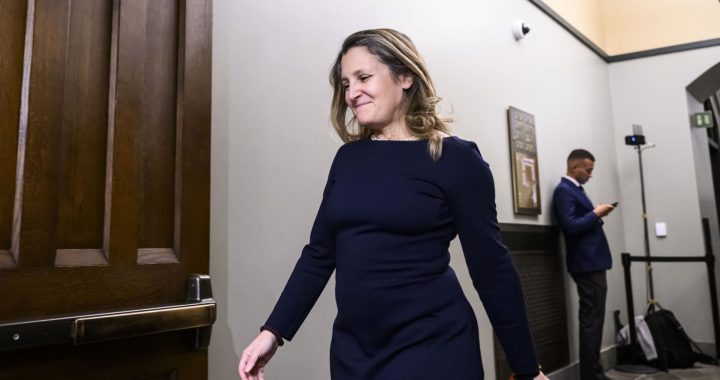
(A side-by-side comparison of health cards issued in Saskatchewan to treaty and non-treaty clients. Photo credit: Alisa Lombard)
APTN Investigates
A policy that allows provincial government employees to instantly know they are dealing with status Indians is now being reviewed, after inquiries made by APTN Investigates.
Eleanore Sunchild, a Cree lawyer from the Thunderchild First Nation whose office is located in Battleford, Sask., says the policy may have affected the jury selection process in the trial of Gerald Stanley.
Stanley was acquitted of second degree murder by a jury that contained no Indigenous members.
The province’s Jury Act lays out two steps that must be followed in compiling potential jury lists. The first step involves health officials randomly drawing from health records to get contact information for a list of 750 people. Then local sheriffs that work for the justice department are supposed to further reduce that list to a more manageable size and randomly select people to be called to court for jury selection.
This week, Maclean’s reported that the second step – required under the Jury Act – has been skipped by justice officials for years.
Sunchild was part of the team representing the family of the late Colten Boushie during the trial. She took issue with Saskatchewan assistant deputy attorney general Anthony Gerein’s comment that the lack of the second selection doesn’t change things.
“I totally disagree because there’s obviously two steps in the Jury Act to ensure fairness. So if one step is to ignore and if the pool – and the way that pool is selected – is not included, that raises questions of potential bias,” she said. “If they did look at the identifiers on the health card and they have ‘R’ on the health card, that’s a big issue. The two draws are intended to ensure randomness. So if one draw is eliminated, how can the government ensure randomness? Especially when you have identifiers of status Indians on the health card or in the health files. It just doesn’t speak to objectivity. I think the two pools were set up to ensure that there was a random selection of juries. So if one is eliminated, it leaves questions.”
Saskatchewan only province to require status on cards
Saskatchewan is the only province or territory in Canada to require race-based information on its health card applications. Health cards issued to status Indians feature a prominent ‘R.’
The provincial government confirmed that health records track race in an email to APTN Investigates.
“An ‘R’ marker on the display of Saskatchewan health cards is a historical practice that eHealth is now reviewing,” Shaylene Salazar, VP of Strategy, Quality and Risk at eHealth wrote. “Stakeholder consultations are planned in order to ensure that no programs or services that may rely on the visual display of the ‘R’ are affected, and will occur over the next few weeks.”
Salazar declined an interview to answer follow-up questions.
eHealth Saskatchewan manages all the health records for the province and, under the province’s Jury Act, is also tasked with providing information to provincial ministry of Justice officials who create lists of prospective juries for provincial court trials.
An investigation into practices across the country revealed that this only happens in Saskatchewan. The government of Nunavut said users could volunteer their status on the application but it would not appear on the card. The Yukon government does ask for status on the application but it is not mandatory or indicated on the card itself.
But a recent report of a letter from the Alberta government addressed to a “treaty Indian” also raises questions about how things are done in that province.
Alberta Health Services called it a data entry error. Premier Rachel Notley apologized for the inappropriate terminology but Sunchild wonders if there’s more to the story.
“Yes, there must be. If we have an ‘R’ on our card, there must be something similar in Alberta. Why else would it be addressed to a ‘status Indian’?” she said.
The fact that health records in Saskatchewan track race was first raised in December by Alisa Lombard, an Indigenous lawyer with Maurice Law working in Ottawa. She called for an end to the practice in a presentation to the Inter-American Commission on Human Rights.
Lombard is spearheading a class action lawsuit alleging the forced sterilization of more than 50 women in the province. She recently presented a letter to the international human rights commission calling for an end to race-based health cards.
“Cease the practice of mandating the disclosure of Indian status in health care applications and the practice of identifying status Indians with an ‘R’ on health cards issued in Saskatchewan,” Lombard’s presentation stated in part.

Sunchild was shocked when informed of the “R” designation by APTN Investigates. As a First Nation citizen she said she was personally affected.
“I feel identified and that isn’t a good feeling. The Jews in Germany were identified using the census so it’s always troubling when you see a certain group of people being identified because the question is for what purpose are they being identified,” she said. “Especially if you’re dealing with a people who have been systematically oppressed. It’s a troubling fact.”
When asked if this adds to concerns that the jury selection process might have been biased in favor of the accused, she said, “It raises big questions that need to be answered, for sure.”
She said the attorney general of Saskatchewan should have considered this information before deciding not to appeal the Stanley acquittal.
“I think they should have looked carefully at the issue of jury selection,” she said.
The lawyer was present for the entire trial, including the jury selection process. With this new information at her disposal, she has other questions now.
“If they selected Indigenous people from remote places – and I know that it seemed to be a lot of northern people in that pool – if those 750 people, the Indigenous people who were selected were from some distance, that to me would show bias because it’s like they’re stacking the deck against their participation. They’re creating barriers to prevent those people from serving on the jury pool.”
With files from Paul Barnsley












What type of information does the Head of the Registrar have access to? and how do they randomly choose people for the first pool?
How does the Inspector of the Court Offices randomly choose people for the second pool?
How large of area is the Geographical Location? Do you think there would be more white potential jurors if the geographical area had a higher white population and low Aboriginal population.
What does “from time to time” under subsection (2) mean?
Just Curious!
What type of information does the Head of the Registrar have access to? and how do they randomly choose people for the first pool?
How does the Inspector of the Court Offices randomly choose people for the second pool?
How large of area is the Geographical Location? Do you think there would be more white potential jurors if the geographical area had a higher white population and low Aboriginal population.
What does “from time to time” under subsection (2) mean?
Just Curious!
Is there a correlation with the way First Nations people are treated in these provinces? Or just a coincidence?
Is there a correlation with the way First Nations people are treated in these provinces? Or just a coincidence?
So, when all other sources State that the jury choses, appeared to be made up of non aboriginals, somehow Sunchild can State unequivically that there where no indiginious persons on the jury! And where did this come from when names, ethnicity, addresses, phone numbers etc, are protected. Hope was she able to make such a statement? The facts are that without an in-depth study of each juror it would be impossible to know. What percentage of persons who didn’t show for Jury Duty were aboriginal? That to me is a more telling fact in this debate!
NWT does the same thing. We are identified as Metis, Status or Caucasian
So, when all other sources State that the jury choses, appeared to be made up of non aboriginals, somehow Sunchild can State unequivically that there where no indiginious persons on the jury! And where did this come from when names, ethnicity, addresses, phone numbers etc, are protected. Hope was she able to make such a statement? The facts are that without an in-depth study of each juror it would be impossible to know. What percentage of persons who didn’t show for Jury Duty were aboriginal? That to me is a more telling fact in this debate!
NWT does the same thing. We are identified as Metis, Status or Caucasian
Murdered and Missing Women are first identified when alive by their Health cards. By health workers gone through special indoctrination of a racist organization. This is happening throughout Canada and people shake their heads to wonder what’s happening. Hitler’s regime is raising its ugly head in rural Sask. Just a slip up the court said of an all white jury we will not appeal. Just look at the health cards. you’ll know immediately how to turn the natives out of their duty to their country. If all else fails.lye when confronted easy to do we will stand behind you. That’s our pledge to you with our secret handshake.
The legislation states the first draw should be big enough to service all of the jury selections not just one.
The head of the registrar picks the first pool, the second pool is chosen by the inspector of court offices, the sheriff does nothing but immediately serve.
Selection of prospective jurors
7(1) In this section, “Inspector of Court Offices” means the Inspector of Court
Offices appointed pursuant to The Court Officials Act, 2012.
(2) The Inspector of Court Offices shall requisition from time to time from the person
in charge of the register maintained for the purposes of subsection 11(1) of The
Saskatchewan Medical Care Insurance Act, the number of names and addresses that
the Inspector of Court Offices anticipates will be required by sheriffs in the province
pursuant to subsection (5).
(3) Notwithstanding any other Act, on receipt of a requisition from the Inspector of
Court Offices pursuant to subsection (2), the person in charge of the register described
in subsection (2) shall randomly select and forward to the Inspector of Court Offices
the requisitioned number of names and addresses.
(4) No information from the register other than the requisitioned names and
addresses is to be forwarded to the Inspector of Court Offices.
(5) Eight weeks before the opening of a jury sitting, each sheriff shall inform the
Inspector of Court Offices of the number of persons who are required as prospective
jurors for the next sitting of the court from the geographical area of the sheriff, as that
area is determined by the Inspector of Court Offices.
(6) On receipt of the information mentioned in subsection (5), the Inspector of Court
Offices shall:
(a) randomly select the number of names and addresses from the names and
addresses provided pursuant to subsection (3); and
(b) forward to the sheriff the number of names and addresses that the sheriff
requires.
(7) Immediately on receipt of the names and addresses pursuant to subsection (6),
the sheriff shall serve each person named at the address indicated with the following:
(a) a Juror Information Return and Summons, in duplicate;
(b) an Application for Relief from Jury Service, in duplicate; and
(c) an envelope addressed to the sheriff, with postage prepaid.
2012, c.C-43.101, s.29.
Do you know what type of information the head of the Registrar has access to? and how they randomly pick people for the first pool?
Also, Do you know how the Inspector of the Court Offices randomly chooses for second pool?
I was just curious.
Murdered and Missing Women are first identified when alive by their Health cards. By health workers gone through special indoctrination of a racist organization. This is happening throughout Canada and people shake their heads to wonder what’s happening. Hitler’s regime is raising its ugly head in rural Sask. Just a slip up the court said of an all white jury we will not appeal. Just look at the health cards. you’ll know immediately how to turn the natives out of their duty to their country. If all else fails.lye when confronted easy to do we will stand behind you. That’s our pledge to you with our secret handshake.
The legislation states the first draw should be big enough to service all of the jury selections not just one.
The head of the registrar picks the first pool, the second pool is chosen by the inspector of court offices, the sheriff does nothing but immediately serve.
Selection of prospective jurors
7(1) In this section, “Inspector of Court Offices” means the Inspector of Court
Offices appointed pursuant to The Court Officials Act, 2012.
(2) The Inspector of Court Offices shall requisition from time to time from the person
in charge of the register maintained for the purposes of subsection 11(1) of The
Saskatchewan Medical Care Insurance Act, the number of names and addresses that
the Inspector of Court Offices anticipates will be required by sheriffs in the province
pursuant to subsection (5).
(3) Notwithstanding any other Act, on receipt of a requisition from the Inspector of
Court Offices pursuant to subsection (2), the person in charge of the register described
in subsection (2) shall randomly select and forward to the Inspector of Court Offices
the requisitioned number of names and addresses.
(4) No information from the register other than the requisitioned names and
addresses is to be forwarded to the Inspector of Court Offices.
(5) Eight weeks before the opening of a jury sitting, each sheriff shall inform the
Inspector of Court Offices of the number of persons who are required as prospective
jurors for the next sitting of the court from the geographical area of the sheriff, as that
area is determined by the Inspector of Court Offices.
(6) On receipt of the information mentioned in subsection (5), the Inspector of Court
Offices shall:
(a) randomly select the number of names and addresses from the names and
addresses provided pursuant to subsection (3); and
(b) forward to the sheriff the number of names and addresses that the sheriff
requires.
(7) Immediately on receipt of the names and addresses pursuant to subsection (6),
the sheriff shall serve each person named at the address indicated with the following:
(a) a Juror Information Return and Summons, in duplicate;
(b) an Application for Relief from Jury Service, in duplicate; and
(c) an envelope addressed to the sheriff, with postage prepaid.
2012, c.C-43.101, s.29.
Do you know what type of information the head of the Registrar has access to? and how they randomly pick people for the first pool?
Also, Do you know how the Inspector of the Court Offices randomly chooses for second pool?
I was just curious.